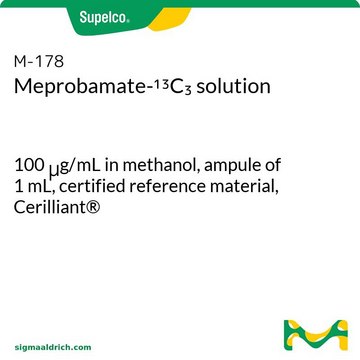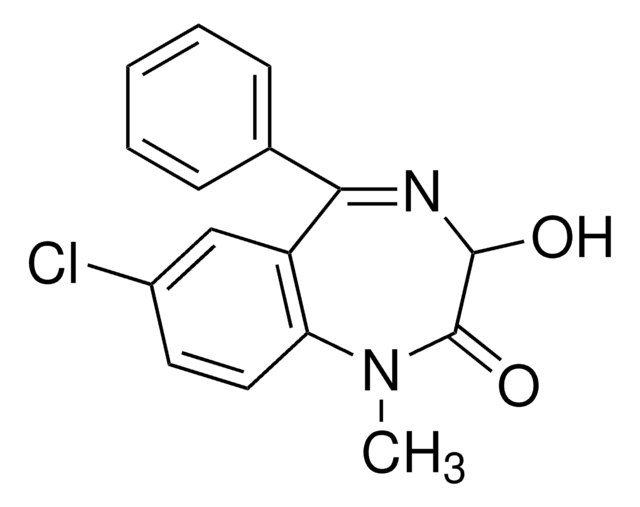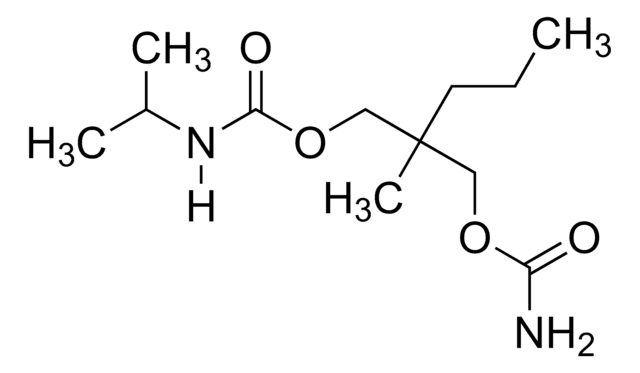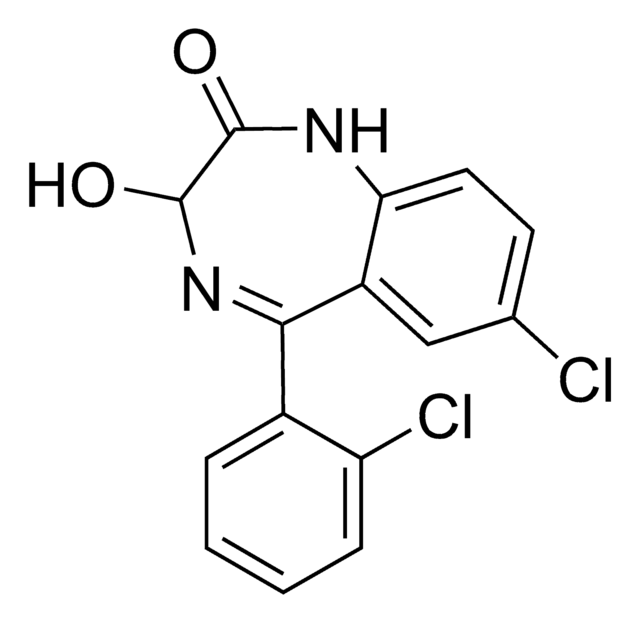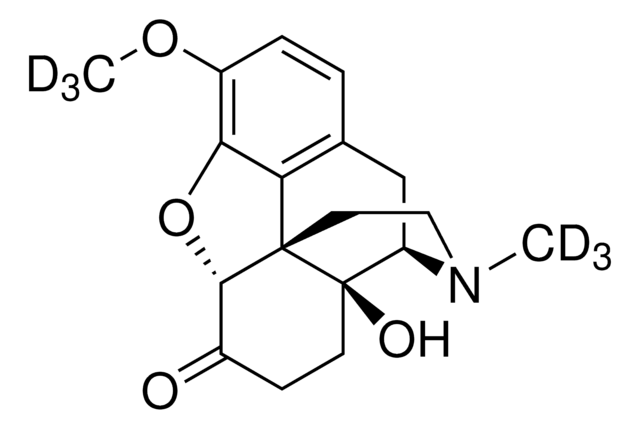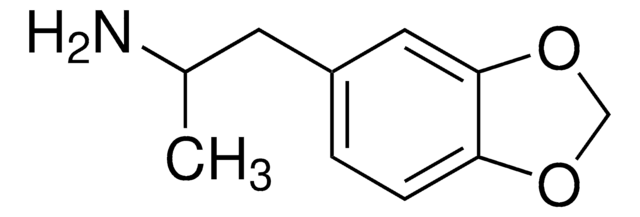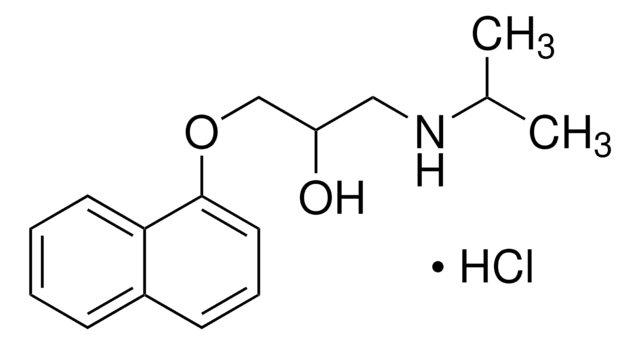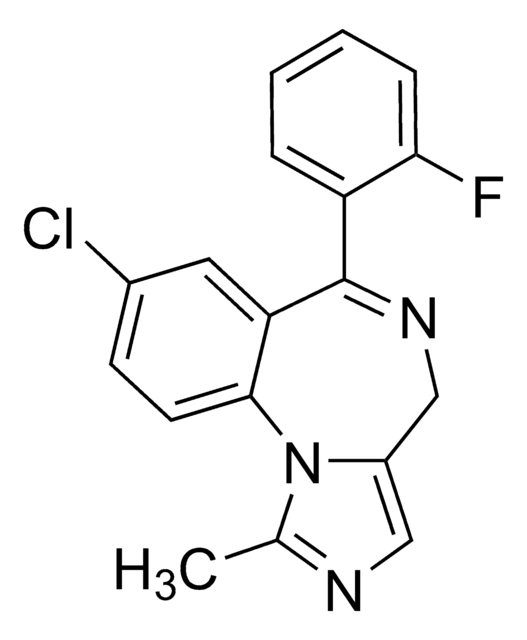M-039
Meprobamate solution
1.0 mg/mL in methanol, ampule of 1 mL, certified reference material, Cerilliant®
About This Item
Produits recommandés
Qualité
certified reference material
Niveau de qualité
Forme
liquid
Caractéristiques
Snap-N-Spike®/Snap-N-Shoot®
Conditionnement
ampule of 1 mL
Fabricant/nom de marque
Cerilliant®
drug control
Narcotic Licence Schedule B (Switzerland); psicótropo (Spain); Decreto Lei 15/93: Tabela IV (Portugal)
Concentration
1.0 mg/mL in methanol
Technique(s)
gas chromatography (GC): suitable
liquid chromatography (LC): suitable
Application(s)
clinical testing
Format
single component solution
Température de stockage
2-8°C
Chaîne SMILES
CCCC(C)(COC(N)=O)COC(N)=O
InChI
1S/C9H18N2O4/c1-3-4-9(2,5-14-7(10)12)6-15-8(11)13/h3-6H2,1-2H3,(H2,10,12)(H2,11,13)
Clé InChI
NPPQSCRMBWNHMW-UHFFFAOYSA-N
Informations sur le gène
human ... GABRA1(2554) , GABRA2(2555) , GABRA3(2556) , GABRA4(2557) , GABRA5(2558) , GABRA6(2559) , GABRB1(2560) , GABRB2(2561) , GABRB3(2562) , GABRD(2563) , GABRE(2564) , GABRG1(2565) , GABRG2(2566) , GABRG3(2567) , GABRP(2568) , GABRQ(55879)
Description générale
Application
- Meprobamate solution for neurotransmitter research: Meprobamate is investigated for its impact on the uptake and translocation of pharmaceutical compounds by vegetables, providing insights into environmental interactions and bioaccumulation potential. This research is valuable for understanding how sedative compounds like meprobamate interact with biological systems beyond their primary pharmacological targets (Wu et al., 2013).
- High-purity meprobamate for in vitro studies: The CNS activities of various plant extracts, including their interaction with CNS depressants like meprobamate, are studied to assess potential synergistic effects and therapeutic applications. Such research is crucial for pharmaceutical and neurological studies, providing a basis for developing new therapeutic strategies (Pal and Samanta, 2011).
- Meprobamate as an anxiolytic agent in pharmacological research: Investigations into the CNS depressant activities of different plant roots highlight the importance of meprobamate as a comparative standard in pharmacological research. These studies are essential for validating the efficacy and safety of new anxiolytic candidates (Pal et al., 2011).
- Meprobamate solution for GABA receptor assay: The evaluation of CNS activities of various natural extracts in comparison with known CNS depressants like meprobamate offers valuable data on their mechanisms of action, particularly concerning GABAergic activity. This research supports the use of meprobamate as a benchmark in neuropharmacological assays (Pal et al., 2009).
- Meprobamate research compound for biochemistry labs: Studies on the CNS effects of botanical extracts using meprobamate as a reference drug help delineate the pathways involved in CNS depression and provide a pharmacological basis for the use of these plants in traditional medicine. This kind of research underpins the development of novel anxiolytic drugs derived from natural sources (Pal, 2008).
Informations légales
Produit(s) apparenté(s)
Mention d'avertissement
Danger
Mentions de danger
Conseils de prudence
Classification des risques
Acute Tox. 3 Dermal - Acute Tox. 3 Inhalation - Acute Tox. 3 Oral - Flam. Liq. 2 - STOT SE 1
Organes cibles
Eyes
Code de la classe de stockage
3 - Flammable liquids
Classe de danger pour l'eau (WGK)
WGK 2
Point d'éclair (°F)
49.5 °F - closed cup
Point d'éclair (°C)
9.7 °C - closed cup
Faites votre choix parmi les versions les plus récentes :
Certificats d'analyse (COA)
Désolés, nous n'avons pas de COA pour ce produit disponible en ligne pour le moment.
Si vous avez besoin d'assistance, veuillez contacter Service Clients
Déjà en possession de ce produit ?
Retrouvez la documentation relative aux produits que vous avez récemment achetés dans la Bibliothèque de documents.
Notre équipe de scientifiques dispose d'une expérience dans tous les secteurs de la recherche, notamment en sciences de la vie, science des matériaux, synthèse chimique, chromatographie, analyse et dans de nombreux autres domaines..
Contacter notre Service technique
